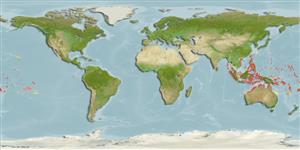>
Blenniiformes (Blennies) >
Blenniidae (Combtooth blennies) > Blenniinae
Etymology: Omobranchus: Greek, omo = shoulder + Greek, brangchia = gill (Ref. 45335).
More on author: Garman.
Environment: milieu / climate zone / depth range / distribution range
Ekologi
laut; payau berasosiasi dengan karang; kisaran kedalaman 0 - 3 m (Ref. 90102). Tropical; 28°N - 23°S
Indo-Pacific: Nicobar Islands to Samoa; north to Mariana Is; south to New Caledonia; Palau and eastern Caroline Islands The subspecies Omobranchus rotundiceps rotundiceps (Macleay 1881) occurs in Australia.
Size / Weight / umur
Maturity: Lm ? range ? - ? cm
Max length : 5.6 cm SL jantan/; (Ref. 7050)
Duri punggung (Keseluruhan (total)): 11 - 13; duri punggung lunak (Keseluruhan (total)): 18-21; Duri dubur 2; Sirip dubur lunak: 20 - 23
Adults inhabit mangroves and sheltered bays (Ref. 90102). Occur among corals, rocks, and rubble of shallow waters (Ref. 1602, 58302). Benthic (Ref. 58302). Oviparous. Eggs are demersal and adhesive (Ref. 205), and are attached to the substrate via a filamentous, adhesive pad or pedestal (Ref. 94114). Larvae are planktonic, often found in shallow, coastal waters (Ref. 94114).
Oviparous, distinct pairing (Ref. 205).
Myers, R.F., 1991. Micronesian reef fishes. Second Ed. Coral Graphics, Barrigada, Guam. 298 p. (Ref. 1602)
Status IUCN Red List (Ref. 130435)
ancaman kepada manusia
Harmless
penggunaan manusia
informasi lanjut
AcuanBudidaya airprofil budidaya airStrainGenetikaElectrophoresesDiturunkanPenyakit-penyakitPengolahanNutrientsMass conversion
mitraGambarStamps, Coins Misc.Suara-suaraCiguateraKecepatanTipe renangArea insangOtolithsOtakPenglihatan / visi
Alat, peralatan
laporan khas
muat turun XML
Sumber internet
Estimates based on models
Preferred temperature (Ref.
123201): 26.8 - 29.3, mean 28.7 °C (based on 1894 cells).
Phylogenetic diversity index (Ref.
82804): PD
50 = 0.5000 [Uniqueness, from 0.5 = low to 2.0 = high].
Bayesian length-weight: a=0.01122 (0.00514 - 0.02450), b=3.04 (2.87 - 3.21), in cm total length, based on all LWR estimates for this body shape (Ref.
93245).
Trophic level (Ref.
69278): 2.7 ±0.2 se; based on size and trophs of closest relatives
Daya lenting (Ref.
120179): Tinggi, Waktu penggandaan populasi minimum kurang dari 15 bulan (Preliminary K or Fecundity.).
Fishing Vulnerability (Ref.
59153): Low vulnerability (10 of 100).
Nutrients (Ref.
124155): Calcium = 199 [102, 425] mg/100g; Iron = 1.03 [0.57, 1.78] mg/100g; Protein = 18.9 [17.8, 20.0] %; Omega3 = 0.145 [0.076, 0.278] g/100g; Selenium = 12.9 [6.1, 27.5] μg/100g; VitaminA = 163 [48, 546] μg/100g; Zinc = 3.23 [2.09, 4.82] mg/100g (wet weight);
